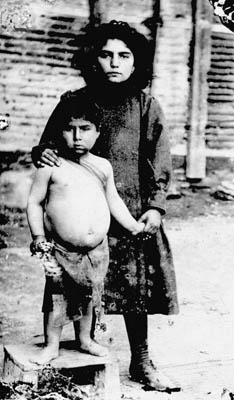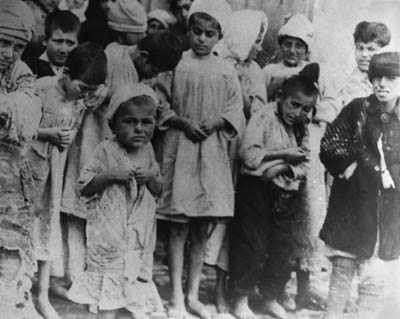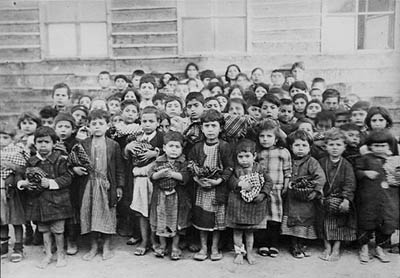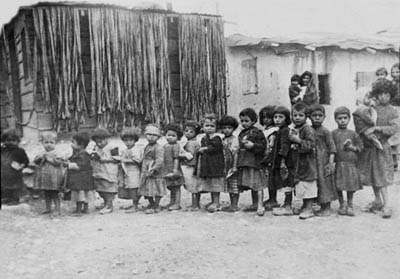
Armenian children in kindergarten society "Azganver" in Talas,
province of Angora, 1910.
Nubaryan Library, Paris
The biggest operation of mass burning of children was carried out in the Bitlis province. Swedish missionary Alma Yohanason, which manages the German orphanages in Mush, in particular, reported that they were burned alive, many defenseless Armenian women and children hiding in their shelter. The mass burning also took place at Deir Zor, where orphans, first collected and herded into a huge building the shelter, after which their groups were taken to the place is an hour's walk from the city, it poured with kerosene and burned. This method of killing of children has also been applied in the provinces of Diyarbakir and Kharberd.
During these years, the Turkish doctors to kill Armenian children also used the method of poisoning. Survivors testified that in the provinces of AGN and Kharberd involving the local pharmacist and doctor have been poisoned by some 500 Armenian orphans. The genocide was carried out in various ways in the province of Trabzon. Two Turkish doctor - Health Services Inspector Dr. Ziya Fuad, and the head of the health services of Dr. Adnan - testified, based on reliable facts obtained from the local Turkish physicians that Dr. Saliba, Ali, head of health services Trabzon province, systematically poisoned Armenian infants who were brought to the city hospital of the Red Cross, and ordered to drown in the Black Sea, the children who refused to take his "medicine." The room filled with Armenian babies, Dr. Saliba applied another method of poisoning, called "steam bath".

Family Momdzhyanov, Ayntap, 1897
Collection of the Museum-Institute of Armenian Genocide
After the deportation, when the number of orphans left helpless, the policy of the Turkish authorities to exterminate the Armenian children became more outspoken. The Turkish government has opened several shelters for these children, and Talaat ordered to assemble, and leave them only those orphans who could not remember how their parents were tortured. The rest were to be sent with caravans deported. Danish missionary, Sister Hansima Marcher, visited one of these shelters, and was surprised: she had found it about 700 Armenian children - all were well clothed and fed, - but, when she again visited the orphanage a few days, then 700 children have only 13, the rest disappeared. They were thrown into the lake, where in one summer were drowned ten thousand Armenian children.
It should be noted that many of the orphans over the years have been picked up by the Turks, Kurds and Arabs. They were foster children in their families and were converted to Islam. Orphans in some shelters, such as in Aynture also underwent a change of religion. Over the next few years the efforts of various organizations and individuals, thousands of children have been released. Those children who survived the genocide, had to face many difficulties and trials in the way of preserving their religious and national identity.
Based on the book V.Dadryana "Children as victims of genocide: the case of the Armenians." Questions of history and historiography of the Armenian Genocide. Volume 7, MIGA, Yerevan, 2003.

The Turks of Armenian skinned child, Istanbul
Lithography Burin de Van Luik (1649-1712), Amsterdam, 17th century

Massacre of Armenians
A sketch made by a witness horrific massacres software (fanatical Muslim students), near Sophia
«Turkey and the Armenian Atrocities», Venerable. Edwin M.Bliss
Edgewood Publishing Company, 1896, page 432

Massacre of Armenians in Sasun
A sketch made by an eyewitness
«Turkey and the Armenian Atrocities» St. Edwin M.Bliss
Edgewood Publishing Company, 1896, page 306

Armenian children - victims of the massacre in Erzurum. Photos in 1895
Nubaryan Library, Paris

Armenian orphans after the 1896 riots gamidovskih
Photo D.Ermakova
From the Collection of the Armenian National Archives

Armenian children from Adana. Their bodies were cut off chunks of flesh and broken knees
Ernst Jaeckh, Der Aufsteigende Halbmond
"Images that Horrify and Indict: Pictorial Documents on the Persecution and Extermination of Armenians from 1877 to 1922" Tessa Hofmann & Gerayer Koutcharian,
Armenian Review, Spring / Summer 1992, Volume 45, № 1-2/177-178, page 78, fig. 13

Vanudzhyan Khatun, 4 years. Was wounded by Turkish bullets that killed her grandmother
Adana, 1909
From the collection of M.Pabudzhyana

Armenian orphans Adana, 1909
Armenian Yearbook H.Nersisyana «Amenun Tarecuyc 1910," Constantinople, s.378

Starving Armenian woman and her son in the desert of Syria, 1916
Collection of the Museum-Institute of Armenian Genocide

Deported Armenian children on the road from Van to Erivan province (Russia), Summer 1916
From the Collection of the Russian Ethnographic Museum

Armenian woman and her two children who died from hunger, 1915
From the collection of Armin Wegner Society

Armenian refugee children
From the collection of St. Lazar Congregation Mkhitarists Island, Venice

Tortured Armenian woman and her child
Published in Russian-language newspaper "Iskra", October 18, 1915

Starving Armenian children were deported to the desert, 1915
From the collection of St. Lazar Congregation Mkhitarists Island, Venice

Turkish official taunting starving bread of Armenian children, 1915
From the collection of St. Lazar Congregation Mkhitarists Island, Venice

Armenian children who died from hunger, 1916
From the collection of Armin Wegner Society

So tens of thousands of people looked to the time when it was first aid
"Story of Near East Relief", James L.Barton, New York, 1930, page 22
From the Collections Committee for Aid to the Middle East

Armenian children - victims of Turkish brutality
Published on the front page weekly "Armenian Journal", November 27, 1916

The funeral of a family of refugees from Western Armenia in Yerevan province. Summer 1915
From the Collection of the Armenian National Archives

Remains of Armenian children, drowned in the Black Sea, Trabzon, 1916
"Album of refugees 1915-1916 gg."

Collection of orphans and lost children during the exodus from Wang, 1915
"Album of refugees 1915-1916 gg."

The family of Armenian refugees, 1915
From the Collection of the Library of Congress

Died from exhaustion deported Armenian child Kharberd, 1915
Jacobsen, DIARY 1907-1919, KHARPUT, TURKEY
Tessa Hofmann & Gerayer Koutcharian
Armenian Review, Spring / Summer 1992, Volume 45, № 1-2/177-178, page 124, Fig. 61

Armenian orphans in Vagharshapat (Echmiadzin), Summer 1915
From the Collection of the Armenian National Archives

The family of Armenian refugees
"Story of Near East Relief", James L.Barton, New York, 1930, page 242
From the Collections Committee for Aid to the Middle East

Arek Manoogian Armenian children, Mush, 1916
From the Collection of Bodil Bjorn
The Norwegian State Archives

A widow with children Reyas Harutyunyan, Mush, 1916
From the Collection of Bodil Bjorn
The Norwegian State Archives

A widow with children Varduhi Petrosyan, Mush, 1916
From the Collection of Bodil Bjorn
The Norwegian State Archives

Scrag
"Story of Near East Relief", James L.Barton, New York, 1930, page 262
From the Collections Committee for Aid to the Middle East

The children, selected by the Committee of the Middle East
Maria Jacobsen, DIARY 1907-1919, KHARPUT, TURKEY
Tessa Hofmann & Gerayer Koutcharian
Armenian Review, Spring / Summer 1992, Volume 45, № 1-2/177-178, page 119, Fig. 56

Armenian orphans in Deir Zor, 1919
From the collection of David Adamian
From the Collection of the Armenian National Archives

One of the many Armenian children, emaciated to a skeleton state, Kharberd, 1915
Maria Jacobsen, DIARY 1907-1919, KHARPUT, TURKEY
Tessa Hofmann & Gerayer Koutcharian
Armenian Review, Spring / Summer 1992, Volume 45, № 1-2/177-178, page 121, Fig. 58

Mushegik Deasy from the village of Van province shows the marks of crucifixion on his hands, 1915
From the Collection of the Armenian National Archives

Armenian orphans, picked up in the desert of Deir Zor (center David Adamian), 1919
From the collection of David Adamian
From the Collection of the Armenian National Archives

Oturechennye Armenian orphans in the orphanage Ayntura (center Khalid Oedipus), 1917
Aram Antonian "Memoirs of Naim Bey", 1920, p.9

Jemal Pasha examines oturechennyh Armenian orphans in Damascus, 1917
Aram Antonian "Memoirs of Naim Bey", 1964, p.24

Oturechennye Armenian orphans in a Turkish orphanage Ayntura
From the collection of Misak Keleshyana

Armenian orphans in Alexandropol. They get half a pound of bread a day and a sugar cube
From the collection of the magazine "National Geographic", Volume XXXVI, № 5, November 1919, str.409

In 1922-1923, the Committee Near East Relief evacuated 22,000
children from orphanages in the center of Turkey, Syria and Greece
In this photo - of the children of the five thousandth column, moving down the road from the Kharberd foot and on donkeys
"Story of Near East Relief", James L.Barton, New York, 1930, page 152
From the Collections Committee for Aid to the Middle East

Evacuation Jacob Kyuntslerom 8000 Christian orphans from Turkey, 1922
"In the land of blood and tears. Experiences in Mesopotamia during the World war (1914-1918) ",
Jacob Kyuntsler, 1999, page 126 (German edition)

The result of the rescue operation one day, Yerevan. Picture taken Melville Chater
From the collection of the magazine "National Geographic", Volume XXXVI, № 5, November 1919, str.408

Children waiting to receive under the snow in the "City of Orphans." The daily spectacle of the early morning to late evening
"Story of Near East Relief", James L.Barton, New York, 1930, page 124
From the Collections Committee for Aid to the Middle East

Armenian orphans

Armenian children, freed from Arab families
From the Collection of Karen Eppe

Armenian children, freed from the Kurdish and Turkish families
From the Collection of Karen Eppe

Begging homeless
Armenian orphans at the door of the orphanage in Gyumri
From the Collections Committee for Aid to the Middle East
Tessa Hofmann & Gerayer Koutcharian
Armenian Review, Spring / Summer 1992, Volume 45, № 1-2/177-178, page 144, Fig. 81

Returning to Adana Armenian children, 1918
In 1920, many of them were killed, others re-deported
From the Collection of the Armenian National Archives

The group of orphan girls at summer camp by the Committee of the Middle East.
Below: Alexandroupoli: "Hands up" mass charge at the landfill. October 1925
"Story of Near East Relief", James L.Barton, New York, 1930, page 21

One of the classes of the school day with the teacher Marguerite Mush.
Teacher Marguerite Nalbandian and most of the 120 school children were killed in 1915
This postscript to the photo was taken Bodil Bjorn:
"All of them were killed in 1915"
The Norwegian State Archives
Photos taken from the following sources: Nubaryan Library, Paris; archive MIGA, Russian Museum of Ethnography, the Order of St. Lazar Mkhitarists Island, Venice, Armenian National Archives, Assembly Committee for Aid to the Middle East, a collection of Misak Keleshyana, Norwegian State Archives
__._,_.___
" Minuman para Anbia : http://higoat-2009.blogspot.com/"
" Anda masih mencari jodoh? Lawati http://www.myjodoh.net"
" Kertas Soalan Ramalan Matematik 2010 : http://maths-catch.com/exam"
" Kedai Maya : http://halawahenterprise.blogspot.com/"
" Blog Sahabat RG : http://azwandengkil.blogspot.com"
Terima kasih kerana sudi bersama kami. Untuk mendapatkan maklumat lanjut tentang ReSpeKs Group, sila ke : http://respeks-group.blogspot.com.
Segala email yang tersiar melalui Respeks Group adalah tanggungjawab penulis asal email. Owner atau moderator tidak bertanggungjawab ke atas setiap email yang disiarkan dan sebarang dakwa dakwi tiada kena mengena dengan moderator group.
" Anda masih mencari jodoh? Lawati http://www.myjodoh.net"
" Kertas Soalan Ramalan Matematik 2010 : http://maths-catch.com/exam"
" Kedai Maya : http://halawahenterprise.blogspot.com/"
" Blog Sahabat RG : http://azwandengkil.blogspot.com"
Terima kasih kerana sudi bersama kami. Untuk mendapatkan maklumat lanjut tentang ReSpeKs Group, sila ke : http://respeks-group.blogspot.com.
Segala email yang tersiar melalui Respeks Group adalah tanggungjawab penulis asal email. Owner atau moderator tidak bertanggungjawab ke atas setiap email yang disiarkan dan sebarang dakwa dakwi tiada kena mengena dengan moderator group.
.
__,_._,___
No comments:
Post a Comment